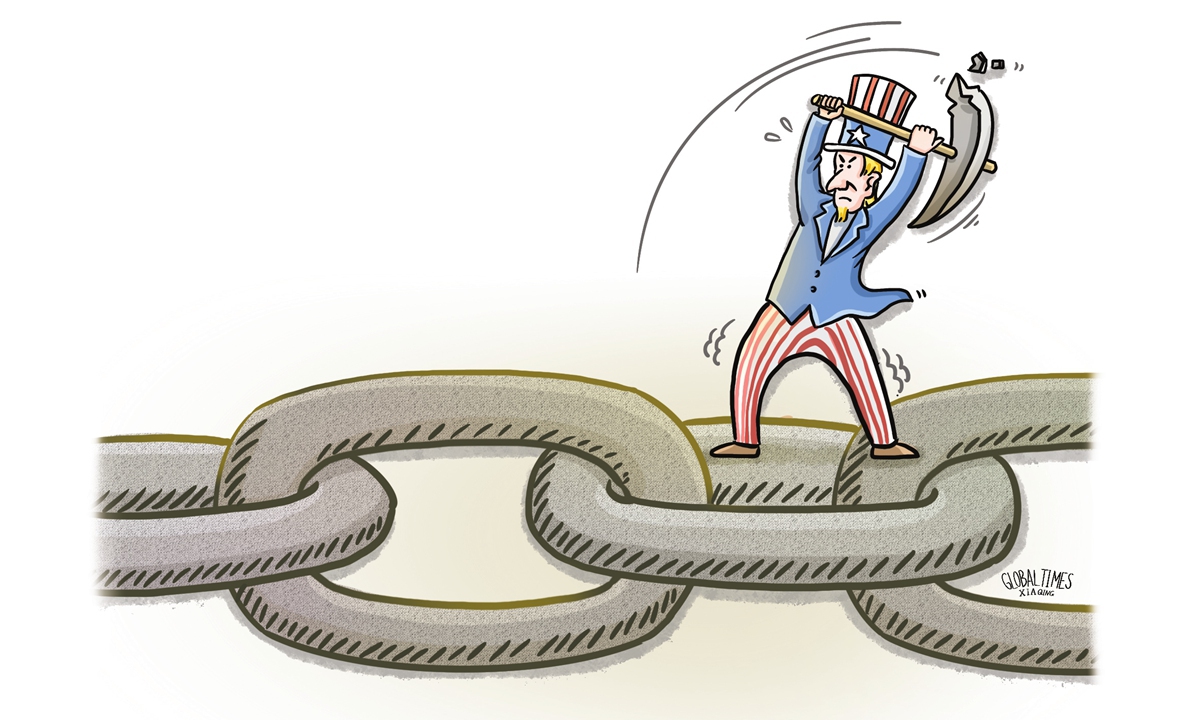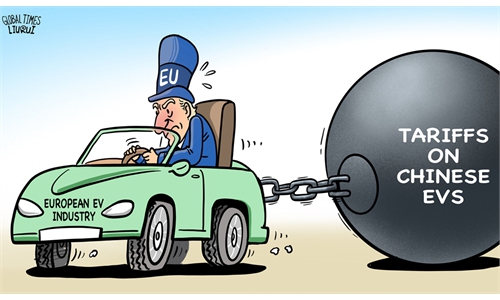
Illustration: Xia Qing/Global Times
US Treasury Department on Monday finalized a new rule meant to prevent US-based people and companies from investing in the development of a range of advanced technologies in China, thereby preventing China from accessing cutting-edge expertise and equipment. Some US media outlets have summarized the Joe Biden administration's economic strategy toward China as a "three-legged" strategy.
The first "leg" involves providing subsidies to domestic industries to enhance their competitiveness. In practice, the Biden administration has allocated hundreds of billions of dollars in subsidies to the new energy and Semiconductor industries through the Inflation Reduction Act, the CHIPS and Science Act, among others.
The second "leg" involves imposing tariffs on Chinese goods to limit their entry into the US market. In addition to continuing the tariffs established during the Trump administration, the Biden administration announced new increases in trade tariffs on $18 billion worth of Chinese imports in May of this year.
The third "leg" focuses on controlling funds and technologies that could benefit China's industrial upgrading. This is particularly evident in the Biden administration's ongoing tightening of restrictions on bilateral investment with China and export controls on high-tech products. However, this strategy reveals the US government's misreading of the international economy and China-US relations. The US government cannot pursue foreign strategies without constraints and consequences. The challenges to the US government's "three-legged" strategy are even more pronounced when facing a major power like China.
In providing domestic industry subsidies, the US government faces dual challenges. At home, these subsidies have not substantially propelled the development of domestic industry. Abroad, the US is heavily subsidizing its own industries, which not only harms the economic interests of its allies but also significantly undermines its previous vehement criticism of the legitimacy of China's industrial policies.
Regarding tariffs, although the US government insists on and expands tariffs against China, its goal of stifling China's foreign exports has failed. Even if the US closes its market to China, Chinese manufacturing retains global competitiveness as long as it maintains cost or technological advantages. Instead of suppressing China, high tariffs from the US create significant difficulties for the US itself. The cost of tariffs has consistently been transferred to the US domestic market, exacerbating inflation within the country.
Regarding the control of investment and technology, the US government faces enormous challenges. The unilateral investment restrictions and export controls imposed on China have encountered both overt and covert resistance from various industries in America. In pursuit of so-called strategic interests, the US government is clearly sacrificing the actual commercial benefits of relevant domestic industries. China's technological advancements have not stalled due to the US' blockade. Relevant Chinese companies have adopted a self-reliant approach and achieved remarkable technological breakthroughs. As a result, American business interests have indeed been harmed by US government.
Therefore, the "three-legged" strategy of the US government toward China is inherently flawed in each of its facets and faces difficulties in reality. From a broader economic perspective, regardless of how it is packaged, the core of the "three-legged" strategy represents a resurgence of American nationalism. The US government intensifies its interference in the market under the guise of national security, disrupting the previously normal international division of labor through protectionism. This "three-legged" strategy is not only counterproductive but also poses a significant test of the US government's governance capacity.
It should also be noted that the US government's "three-legged" strategy is not a response to the trends of our times, but rather a reaction against the them. It is destructive rather than constructive, requiring more resources while yielding few results.
The author is the deputy director of the Center for American Studies at Fudan University. opinion@globaltimes.com.cn



